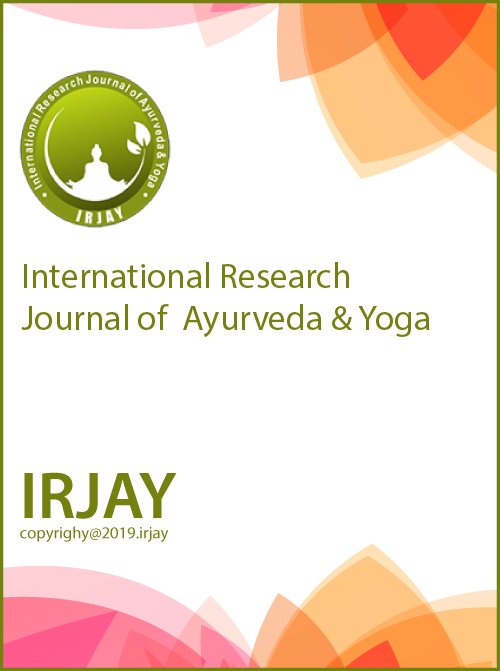Comparative Analysis of Slow Su _ ryanamaskau _ r with Awareness and Proper Breathing versus Fast Suu _ ryanamaskau _ r on Anxiety and Fatigue Levels in College Students
DOI:
https://doi.org/10.48165/IRJAY.2025.80301Keywords:
Anxiety, College Students, Fatigue, Mental Health, Stress Reduction, Sūryanamaskār, YogaAbstract
Background: Sūryanamaskār (Sun Salutation) is a dynamic sequence of yoga postures that integrates movement, breath, and awareness. It is widely practiced for its physical, mental, and spiritual benefits. Variations in speed and intensity can influence its physiological and psychological effects. Anxiety and fatigue are prevalent concerns among college students due to academic pressure and lifestyle factors while Yoga has been recognized as an effective intervention for stress reduction, the comparative impact of slow and fast Sūryanamaskār on anxiety and fatigue remains underexplored. Aim: This study aims to compare the effects of slow Sūryanamaskār with awareness and proper breathing versus fast Sūryanamaskār on anxiety and fatigue levels in college students. Materials and Methods: The study followed an interventional pre-test and post-test design, involving 80 students from Dr. Shyama Prasad Mukherjee College of Physical Education, Nurpur, Kangra, Himachal Pradesh. Participants were randomly assigned to two interventional groups: Group A (Fast Sūryanamaskār) – 40 students and Group B (Slow Sūryanamaskār) – 40 students. Anxiety levels were assessed using the Beck Anxiety Inventory, and fatigue levels were measured through the Fatigue Severity Scale. Both assessments were conducted before and after the intervention. Intervention: Participants engaged in an 8-week structured yoga program, practicing 6 days a week under the supervision of a certified Yoga instructor. Group A (fast Sūryanamaskār) performed 36 rounds at a pace of 30 s/ round, emphasizing speed and rhythm rather than awareness. Group B (Slow Sūryanamaskār) performed 36 rounds at a pace of 1 round/min, focusing on breath awareness and mindfulness. Each session included 10 min of Sukshma Vyayama (preparatory exercises) and 4 minutes of Shavasana (relaxation) post-practice. Results: The statistical analysis using paired and independent t-tests showed that: Group A exhibited a minor reduction in anxiety (pre-test mean = 26.99, post-test mean = 25.79; t = 1.0709), but it was not statistically significant. Group B showed a significant reduction in anxiety (pre-test mean = 26.75, post-test mean = 21.32; t = 3.3837, P < 0.05). Asimilar pattern was observed for fatigue levels, with GroupB demonstrating a highly significant reduction compared to GroupA. Conclusion: The study highlights that slow-paced Sūryanamaskār is significantly more effective in reducing anxiety and fatigue compared to its fast-paced counterpart. The intensity and physiological engagement of slow Sūryanamaskār likely contribute to its superior benefits. Future research should investigate the neurophysiological mechanisms and long-term impacts of these variations on mental health.
Downloads
References
Satyananda S. Asana, pranayama, mudra, bandha. Bihar: Bihar School of Yoga; 2008.
Mody BS. Acute effects of Surya Namaskar on the cardiovascular & metabolic system. J Bodyw Mov Ther. 2011;15(2):343-7. 3. American College Health Association. National college health assessment III: Reference group executive summary. Maryland: American College Health Association; 2021.
Spielberger CD. State-trait anxiety inventory. New Delhi: Mind Garden; 2010.
Liu X, Zheng J, Liu K, Baggs JG. The impact of stress on fatigue and cognitive function. J Adv Nurs. 2020;76(2):455-64.
Field T. Yoga clinical research review. Complement Ther Clin Pract. 2011;17(1):1-8.
Telles S, Singh N, Balkrishna A. Heart rate variability changes during high frequency yoga breathing and breath awareness. BMC Complement Alternat Med. 2011;11(1):86.
Bera TK., Gore MM, Oak JP. Recovery from stress in two different postures and in Shavasana--A yogic relaxation posture. Indian J Physiol Pharmacol. 1998;42(4):473-8.
Beck AT, Epstein N, Brown G, Steer RA. An inventory for measuring clinical anxiety: Psychometric properties. J Consult Clin Psychol. 1988;56(6):893-7. doi: 10.1037/0022-006X.56.6.893
Krupp LB, LaRocca NG, Muir-Nash J, Steinberg AD. The fatigue severity scale. Application to patients with multiple sclerosis and systemic lupus erythematosus. Arch Neurol. 1989;46(10):1121-3. doi: 10.1001/archneur.1989.00520460115022
Saraswati S. Dynamics of yoga: The foundations of Bihar yoga. Bihar: Bihar School of Yoga; 2017.
Singh R, Udupa K. Influence of yogic practices on mental health: A systematic review. Indian J Psychol Wellbeing. 2018;9(2): 112-9.
Telles S, Singh N, Balkrishna A, Gupta RK. Effect of fast and slow pranayama on perceived stress and cardiovascular parameters: A comparative study. Int J Yoga. 2020;13(1):15-20.


